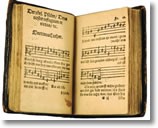by Katie Schuermann

A composer can never escape his own style, and this is true even of amateur composers such as Martin Luther.
Our beloved reformer was a competent musician in his own right. Embracing the musical arts in both his schooling and his cloistered life, Luther became a proficient instrumentalist on the lute and the transverse flute. He was an admirer of the polyphonic composers of his day—the great Josquin des Prez in particular—and his admiration made him bold to attempt composing many-voiced works of his own. It should be no surprise to us that music, as well as doctrine, played a major part in Luther’s church reforms.
Before Luther’s time, congregations rarely spoke let alone sang during a church service. There were special occasions such as processionals and festivals which called for corporate singing, but congregational song was not standard procedure during the Divine Service in sixteenth-century Germany. Luther’s moving of congregational singing to the forefront in the service was another bold move consistent with his personality and doctrine. Even more daring was his having the congregation sing in their vernacular language. Up to this point in time, Latin was the primary language spoken and sung in church. There were hymns and carols sung in the common language of the people which date back as early as the Middle Ages, but this was the exception rather than the rule.
Luther’s German hymn texts were set to modal melodies rather than to the strict metered melodies to which our modern ears are accustomed. These modal melodies followed more closely the natural rhythm of speech.
“Luther’s hymns were meant not to create a mood, but to convey a message. They were a confession of faith, not of personal feelings. That is why, in the manner of folk songs, they present their subject vividly and dramatically, but without the benefit of ornate language and other poetic refinements. They were written not to be read but to be sung by a whole congregation.” (Luther’s Works, Volume 53, Page 197)
Luther also composed in a more monosyllabic style when setting his familiar German to music, somewhat rejecting the more melismatic style of Latin plainchant that was prolific in the church at the time. His hymns clearly evoke the textural and musical patterns of German folk songs as well as the disjointed, irregular style more in line with sixteenth-century polyphony. His melodies were provocative, too, utilizing unexpected intervals of fourths and fifths as well as syncopated rhythms which jolted and jarred the listener in much the same way as his writings and sermons. Luther’s more angular style of writing and composing has since been polished by English translators and arrangers in the nineteenth century.

There has been some speculation as to whether or not Luther composed the music for his own hymns. Composers were not listed in sixteenth-century hymnals, so it is more difficult to know who composed the music for Luther’s new hymns. Many musicologists today are comfortable accepting Luther as the composer of his own hymn’s melodies (especially those included in the Wittenberg hymnal). Since the poet and the composer were almost always the same person in the sixteenth century, it is safe to let this conclusion stand.
During the Reformation, close to one hundred hymnals were produced between Luther’s nailing of the ninety-five theses on the door of the Castle Church in 1517 and his death in 1546. For such an enormous supply of hymnals to be printed, there must have been a great demand for them. No doubt, Luther’s vernacular, doctrinally-rich hymn texts and his distinct, Germanic music tilled the fertile soil of the Reformation and made it ready for the good seed of congregational singing, a planting which still yields a bountiful harvest today.
Mrs. Katie Schuermann is a member at Good Shepherd Lutheran Church in Sherman, IL.